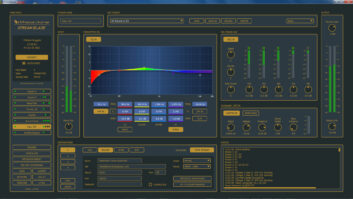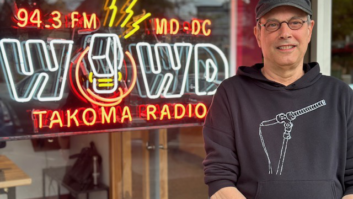For years, the C. Crane Company of Fortuna, Calif., has made its mark by producing high-performance consumer radios. The company’s most notable receiver is the CCRadio-2, an AM/FM/2-meter (ham)/weather band receiver with exceptional AM sensitivity. (President Bob Crane is a dedicated AM talk radio enthusiast who tunes to distant broadcasts.)
However, C. Crane also has generated much favorable response with its AM/FM/shortwave radio sets — the CCRadio-SW and small CCRadio-SWPocket — and its new Web streaming receiver, the CC WiFi Internet Radio.

This is why the $69.95 CCRadio-EP is unique.
Unlike C. Crane’s other receivers, this AM/FM has an old-fashioned analog tuning needle, a large tuning dial and linear tuning scale. No digital interface here.
At the same time, the CCRadio-EP features a built-in Twin Coil Ferrite (TCF) antenna with tuner, an AM signal tuning and boosting device that the company also sells as an outboard unit. Using the side-mounted TCF AM Fine-Tuning knob — located on the right-hand side of the set between the Tuning dial (above) and the large Volume dial (below) — you can boost an incoming AM signal, or null it out almost entirely to nothing.
“The TCF AM fine tuning consists of extra circuitry and two extra coils around the ferrite antenna, which means it really should be called the Quad Coil,” says Bob Crane.
“It is a new experimental design. You do not have to adjust the TCF knob to receive excellent AM performance, but it does have some effect for fine tuning. The TCF will deliver various and perhaps curious results depending on the strength of the AM signal and the time of day.”
Collectively, the CCRadio-EP is an old-fashioned AM/FM portable equipped with cutting-edge tuning capabilities. This makes it an intriguing amalgam of old and new technologies.
“I need to make a radio that my 90-year-old mother — who is still sharp! — could operate without having to learn about digital technology,” Crane says. “But I also needed a receiver that didn’t compromise on performance. Thus the genesis of the CCRadio-EP.
“The customers have done a great job at guessing what EP stands for,” Crane added, “so I am going to let our customers pick the final name.”
Dongguan Redsun Electronic Factory of China manufactures the CCRadip-EP for C. Crane.
Specs
Like the legendary GE SuperRadio II — still one of the finest portables for receiving distant AM signals ever made — the CCRadio-EP is big.
It comes in a flat black plastic case that is 11.4 inches wide, 7.3 inches tall and 2.75 inches deep. When loaded with four D batteries (an AC adaptor comes with the receiver), the CCRadio-EP weighs 4 pounds, 6 ounces. (If swung accurately using this receiver’s top-mounted, fold-down carrying handle, the CCRadio-EP has the potential to deliver a stunning blow to someone’s head.)
The left side of the case houses a 4-inch, 8 ohm, 5W speaker. (There is a mini-plug jack for stereo headsets/earbuds, plus two more for Line In and the AC adaptor.) On the upper right is the horizontal tuning scale, which measures about 6 inches long. The display is backlit, triggered by a top-mounted Light button adjacent to the Power button. In the lower front of the case is a switch for selecting among AM, FM mono and FM stereo. There are also individual tuning knobs for Bass and Treble, plus a third knob that switches between “Music” and “Voice.”
The back of the CCRadio-EP has connections for external AM and FM antennas, plus a switch to change between the internal 7.9-inch ferrite bar and external AM inputs. Add a fold-down three-foot extendable FM whip antenna, and you’ve got the basic set.
The CCRadio-EP covers AM 520–1710 kHz and FM 88–108 MHz, and is only analog. In other words, it does not have HD Radio circuitry.
“These days, Internet receivers are outselling HD radios,” Crane says. “While HD Radio has possibilities on the FM band to expand station and format offerings, I have my doubts about HD Radio as a reception technology for the AM band. I’d rather put my efforts into an analog set that offers better AM selectivity and sound, which is what the CCRadio-EP does.”
AM sensitivity is 60 uV/m for 20 dB SNR, and FM sensitivity is 8 uV/m for 30 dB SNR.
Assessment
Although it designed to hold its own with the CCRadio-2 receiver, the CCRadio-EP is derived from the company’s CCRadio-SW radio. Designed as always by “Mr. Zeng,” a China-based engineer who reportedly loves radio as much as Bob Crane does, the CCRadio-EP delivers full, wide-spectrum audio on both AM and FM.
The Music/Voice switch is designed to improve AM talk radio listening, by running the audio through a 5 kHz filter for clearer voice reproduction. Meanwhile, the FM/FM Stereo switch “allows you to eliminate the FM stereo pilot frequency to get better sound using FM mono,” says Crane. “Since the CCRadio-EP has only one speaker, listening to FM in mono doesn’t lose you anything, but it can improve your overall fidelity.”
When in use side-by-side use, the CCRadio-2 appeared to be marginally more sensitive to distant AM signals. However, the CCRadio-EP’s TCF tuning mechanism allowed this radio to deliver clearer, better fidelity AM audio with less interference from other sources.
The result was that the CCRadio-EP was easier to listen to than the CCRadio-2, e.g., when tuning to WCBS New York on 880 kHz from a distance of roughly 336 miles during the late afternoon. According to C. Crane, this radio’s AM selectivity is rated at –60 dB on first adjacent channels.
This said, the initial production version of the CCRadio-EP that I tested had a very wide filter on FM, and little apparent selectivity. The result is that adjacent stations interfere much more noticeably on the CCRadio-EP than when tuned on the CCRadio-2.
In Ottawa, Canada — where this test was performed — the CCRadio-EP could not separate WRCD “The Fox” at 101.5 MHz (Massena, N.Y.) from CIDG at 101.9 MHz (Ottawa). In contrast, the CCRadio-2 separated the two nicely, with “quiet” to spare.
Notified of this issue, C. Crane sent us a second CCRadio-EP, which Bob Crane characterized as being part of “the first shipment of real production radios.”
Although this radio also has a wider FM filter, it did not experience the same selectivity issues as the first CCRadio-EP. If all succeeding radios meet the second receiver’s standards, FM selectivity should not be an issue for listeners.
In sum, the CCRadio-EP shines on AM, but might have the mentioned issues on FM. I say “might”: It is likely that any CCRadio-EPs that reach consumers will be later models without this issue. But at $69.95, CCRadio-EP is an easy-to-use, affordable consumer-level portable radio.
“There’s no clock radio, no presets; no bells or whistles save for the TCF AM fine tuning,” says Bob Crane. “The CCRadio-EP is a radio pure and simple, with no bones about it.”












